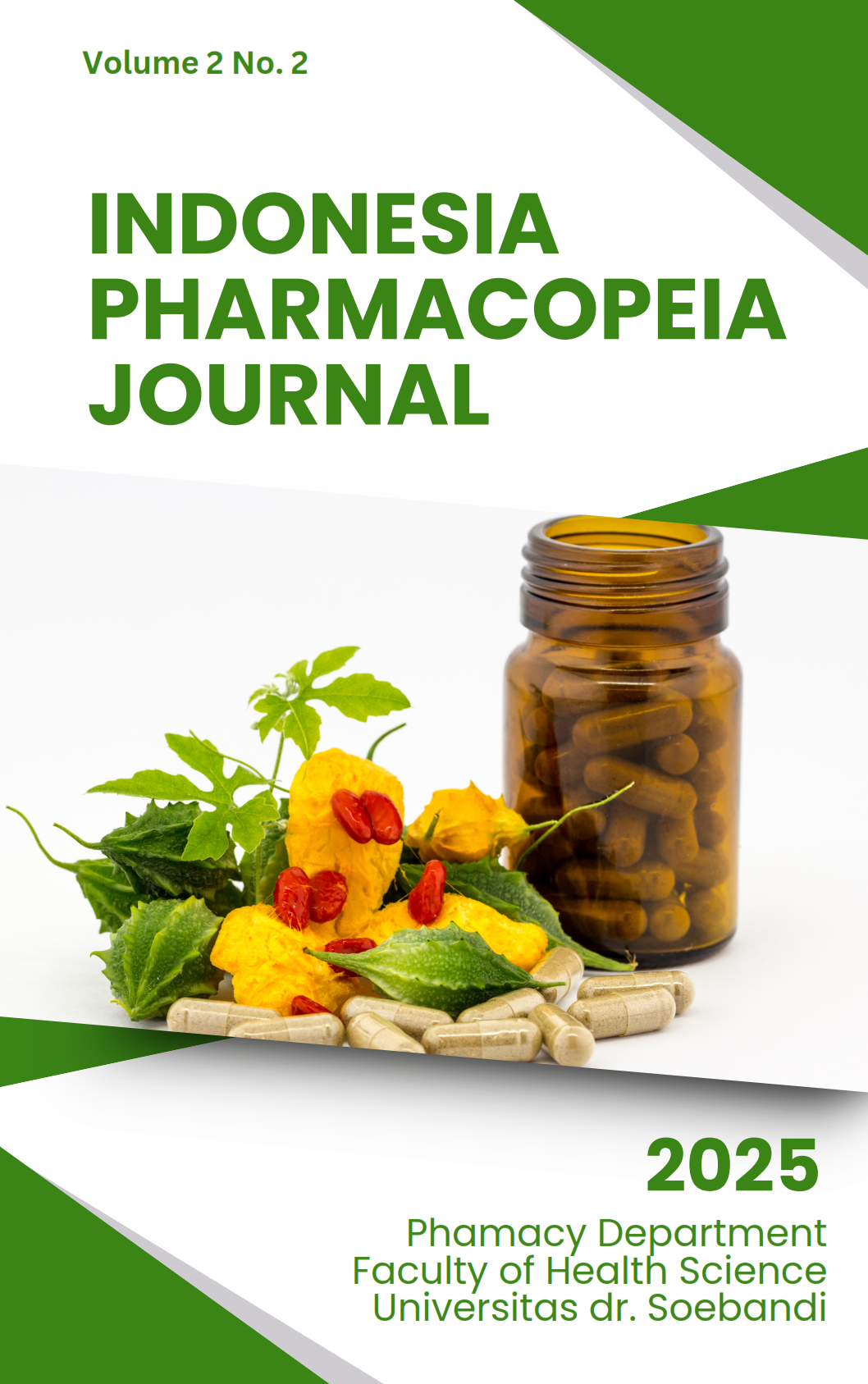The Potential Of Bioactive Compounds Of Moringa oleifera Leaves as α-Glucosidase Inhibitor Reveals Antidiabetic Activity
DOI:
https://doi.org/10.36858/ipj.v2i2.47Keywords:
Type 2 Diabetes Mellitus, Moringa leaves, Molecular docking, α-GlucosidaseAbstract
Type 2 diabetes mellitus is the most common type of diabetes, accounting for approximately 90% of all diabetes cases. The enzyme α-glucosidase is an important therapeutic target due to its role in breaking down carbohydrates into glucose in the small intestine. Moringa leaves (Moringa oleifera) are known to have antihyperglycemic effects through the inhibition of this enzyme, making the active compounds within them a potential natural antidiabetic agent. This study aims to evaluate the physicochemical profile, pharmacokinetics, and bioactivity of six compounds in moringa leaves (4-Undecylbenzenesulfonic acid, Apigetrin, Quercetin-3-β-D-glucoside, D-(-) -Quinic acid, Corchorifatty acid F, and 4-Hydroxybenzaldehyde) using in silico methods, with Voglibose as a control, against the α-glucosidase receptor (PDB ID: 5KZX) via the Hex 8.0.0, PyRx 0.8, and BIOVIA Discovery Studio 2019 applications. The results showed that four compounds (Apigetrin, D-(-)Quinic acid, Corchorifatty acid F, and 4-Hydroxybenzaldehyde) met Lipinski's rules and had good pharmacokinetic profiles. In terms of bioactivity, Apigetrin and D-(-)Quinic acid had Pa values >0.5, indicating potential as antidiabetic agents. Docking analysis revealed that all compounds could interact with α-glucosidase, but their binding energies were still higher than Voglibose (-1425.3 kcal/mol). Among the tested compounds, Apigetrin showed the lowest value (-334.1 kcal/mol). This study suggests that Apigetrin, D-(-)-Quinic acid, Corchorifatty acid F, and 4-Hydroxybenzaldehyde may have potential as candidates for type 2 antidiabetic drugs due to their α-glucosidase inhibitory properties. Based on the binding energy of the compounds found in moringa leaves, they bind outside the active site of the ligand.
References
Alam, N., Budiarsa, I. M., & Tureni, D. (2020). Prediksi Struktur Tiga Dimensi Protein β-NGF (Nerve Growth Factor) Burung Merpati (Columba livia). JURNAL ILMIAH SAINS, 20(2), 106. https://doi.org/10.35799/jis.20.2.2020.28857
Tahir, M., & Maryam, St. (2024). STUDI IN SILICO SENYAWA AKTIF DARI JAHE (Zingiber officinale) DAN KERSEN (Muntingia calabura L.) SEBAGAI INHIBITOR MAIN PROTEASE (Mpro) DARI SARS-CoV-2. As-Syifaa Jurnal Farmasi, 16(1), 35–44. https://doi.org/10.56711/jifa.v16i1.1070
Naufa, F., Mutiah, R., & Indrawijaya, Y. Y. A. (2022). Studi in Silico Potensi Senyawa Katekin Teh Hijau (Camellia sinensis) sebagai Antivirus SARS CoV-2 terhadap Spike Glycoprotein (6LZG) dan Main Protease (5R7Y).
Pardi, N., Hogan, M. J., Porter, F. W., & Weissman, D. (2018). mRNA vaccines—A new era in vaccinology. Nature Reviews Drug Discovery, 17(4), 261–279. https://doi.org/10.1038/nrd.2017.243
Wu, H., Yang, P., Li, A., Jin, X., Zhang, Z., & Lv, H. (2023). Chlorella sp.-ameliorated undesirable microenvironment promotes diabetic wound healing. Acta Pharmaceutica Sinica B, 13(1), 410–424. https://doi.org/10.1016/j.apsb.2022.06.012
Grogan, S., & Preuss, C. V. (2025). Pharmacokinetics. In StatPearls. StatPearls Publishing. http://www.ncbi.nlm.nih.gov/books/NBK557744/
Dahlgren, D., & Lennernäs, H. (2019). Intestinal Permeability and Drug Absorption: Predictive Experimental, Computational and In Vivo Approaches. Pharmaceutics, 11(8), 411. https://doi.org/10.3390/pharmaceutics11080411
Sun, Y., Zabihi, M., Li, Q., Li, X., Kim, B. J., Ubogu, E. E., Raja, S. N., Wesselmann, U., & Zhao, C. (2023). Drug Permeability: From the Blood–Brain Barrier to the Peripheral Nerve Barriers. Advanced Therapeutics, 6(4), 2200150. https://doi.org/10.1002/adtp.202200150
Abdullah, S. S., Putra, P. P., Antasionasti, I., Rundengan, G., Suoth, E. J., Abdullah, R. P. I., & Abdullah, F. (2021). ANALISIS SIFAT FISIKOKIMIA, FARMAKOKINETIK DAN TOKSIKOLOGI PADA PERICARPIUM PALA (Myristica fragransa) SECARA ARTIFICIAL INTELLIGENCE. CHEMISTRY PROGRESS, 14(2), 81. https://doi.org/10.35799/cp.14.2.2021.37112
Yang, Y., & Wang, P. (2020). Association of CYP19A1 and CYP1A2 genetic polymorphisms with type 2 diabetes mellitus risk in the Chinese Han population. Lipids in Health and Disease, 19(1), 187. https://doi.org/10.1186/s12944-020-01366-9
Hakiki, A., Andika, A., & Rahmawati, R. (2024). Studi Molecular Docking dan Prediksi ADMET Senyawa Turunan Kurkumin Sebagai Inhibitor Kasein Kinase 2-α. Lumbung Farmasi: Jurnal Ilmu Kefarmasian, 5(2), 195. https://doi.org/10.31764/lf.v5i2.22563
Pokharkar, O., Lakshmanan, H., Zyryanov, G., & Tsurkan, M. (2022). In Silico Evaluation of Antifungal Compounds from Marine Sponges against COVID-19-Associated Mucormycosis. Marine Drugs, 20(3), 215. https://doi.org/10.3390/md20030215
Daina, A., Michielin, O., & Zoete, V. (2017). SwissADME: A free web tool to evaluate pharmacokinetics, drug-likeness and medicinal chemistry friendliness of small molecules. Scientific Reports, 7(1). https://doi.org/10.1038/srep42717
Ferreira, L., Dos Santos, R., Oliva, G., & Andricopulo, A. (2015). Molecular Docking and Structure-Based Drug Design Strategies. Molecules, 20(7), 13384–13421. https://doi.org/10.3390/molecules200713384
Aziz, F. K., Nukitasari, C., Oktavianingrum, F. A., Aryati, L. W., & Santoso, B. (2016). Hasil In Silico Senyawa Z12501572, Z00321025, SCB5631028 dan SCB13970547 dibandingkan Turunan Zerumbon terhadap Human Liver Glycogen Phosphorylase (1l5Q) sebagai Antidiabetes. Jurnal Kimia VALENSI, 0(0), 120–124. https://doi.org/10.15408/jkv.v0i0.4170
Yoon, S. S., Yun, J., Lee, B. H., Kim, H. Y., & Yang, C. H. (2021). Acupuncture Modulates Intracranial Self-Stimulation of the Medial Forebrain Bundle in Rats. International Journal of Molecular Sciences, 22(14), 7519. https://doi.org/10.3390/ijms22147519
Arini Salsabila Hasibuan, Dwika Ardelya Pratiwi, Maharani Br Barus, & Salshabila Azzahra Sirait. (2023). Studi Literatur: Berbagai Daun Tumbuhan Indonesia Sebagai Antidiabetes. Jurnal Ilmu Kesehatan dan Gizi, 1(3), 122–134. https://doi.org/10.55606/jikg.v1i3.1395
Fachruddin, Suprayogi, A., Manalu, W., Hanif, N., & Darusman, H. S. (2024). Data on characteristics of simplicia, phytoconstituents, and antioxidant activity of Moringa oleifera leaves ethanol extract. Data in Brief, 54, 110425. https://doi.org/10.1016/j.dib.2024.110425
Firmansya, A., Nursiam, D. F., & Ulfah, M. (n.d.) (2024). Studi In Silico Senyawa Katekin Terhadap Reseptor Alpha Glukosidase (3POC) Sebagai Antidiabetes Tipe 2.
Hardianto, D. (2021). TELAAH KOMPREHENSIF DIABETES MELITUS: KLASIFIKASI, GEJALA, DIAGNOSIS, PENCEGAHAN, DAN PENGOBATAN: A Comprehensive Review of Diabetes Mellitus: Classification, Symptoms, Diagnosis, Prevention, and Treatment. Jurnal Bioteknologi & Biosains Indonesia (JBBI), 7(2), 304–317. https://doi.org/10.29122/jbbi.v7i2.4209
Hardjono, S. (2013). SINTESIS DAN UJI AKTIVITAS ANTIKANKER SENYAWA 1-(2-KLOROBENZOILOKSI)UREA DAN 1-(4-KLOROBENZOILOKSI)UREA. 1.
Hasimun, P., & Ketut Adnyana, I. (2019). Zingiberaceae Family Effects on Alpha-Glucosidase Activity: Implication for Diabetes. In Bioactive Food as Dietary Interventions for Diabetes (pp. 387–393). Elsevier. https://doi.org/10.1016/B978-0-12-813822-9.00026-6
Sari, I. W., Junaidin, J., & Pratiwi, D. (2020). STUDI MOLECULAR DOCKING SENYAWA FLAVONOID HERBA KUMIS KUCING (Orthosiphon stamineus B.) PADA RESEPTOR α-GLUKOSIDASE SEBAGAI ANTIDIABETES TIPE 2. Jurnal Farmagazine, 7(2), 54. https://doi.org/10.47653/farm.v7i2.194
Downloads
Published
How to Cite
Issue
Section
License
Copyright (c) 2025 Ayu Tri Agustin, Nabila Al Unaizah, Lulut Sasmito, Mohammad Rofik Usman

This work is licensed under a Creative Commons Attribution-ShareAlike 4.0 International License.




